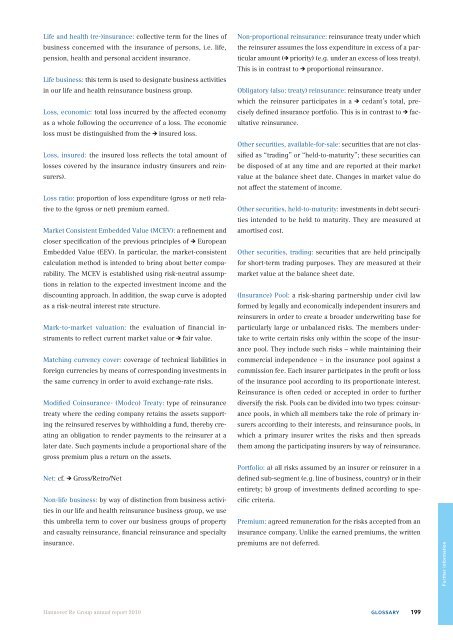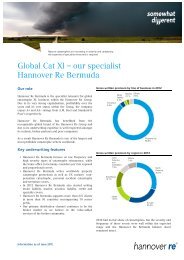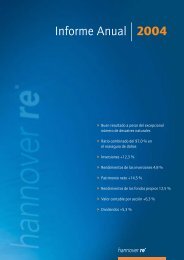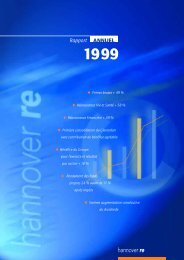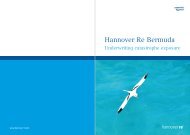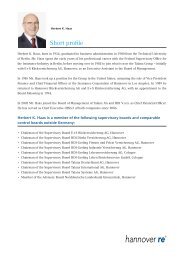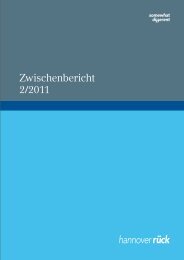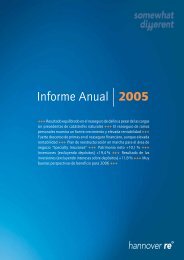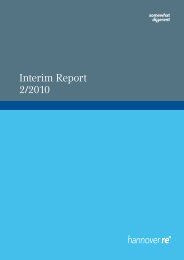Annual Report 2010 - Hannover Re
Annual Report 2010 - Hannover Re
Annual Report 2010 - Hannover Re
You also want an ePaper? Increase the reach of your titles
YUMPU automatically turns print PDFs into web optimized ePapers that Google loves.
Life and health (re-)insurance: collective term for the lines of<br />
business concerned with the insurance of persons, i.e. life,<br />
pension, health and personal accident insurance.<br />
Life business: this term is used to designate business activities<br />
in our life and health reinsurance business group.<br />
Loss, economic: total loss incurred by the affected econ omy<br />
as a whole following the occurrence of a loss. The economic<br />
loss must be distinguished from the insured loss.<br />
Loss, insured: the insured loss reflects the total amount of<br />
losses covered by the insurance industry (insurers and reinsurers).<br />
Loss ratio: proportion of loss expenditure (gross or net) relative<br />
to the (gross or net) premium earned.<br />
Market Consistent Embedded Value (MCEV): a refinement and<br />
closer specification of the previous principles of European<br />
Embedded Value (EEV). In particular, the market-consistent<br />
calculation method is intended to bring about better comparability.<br />
The MCEV is established using risk-neutral assumptions<br />
in relation to the expected investment income and the<br />
discounting approach. In addition, the swap curve is adopted<br />
as a risk-neutral interest rate structure.<br />
Mark-to-market valuation: the evaluation of financial instruments<br />
to reflect current market value or fair value.<br />
Matching currency cover: coverage of technical liabilities in<br />
foreign currencies by means of corresponding investments in<br />
the same currency in order to avoid exchange-rate risks.<br />
Modified Coinsurance- (Modco) Treaty: type of reinsur ance<br />
treaty where the ceding company retains the assets supporting<br />
the reinsured reserves by withholding a fund, thereby creating<br />
an obligation to render payments to the reinsurer at a<br />
later date. Such payments include a proportional share of the<br />
gross premium plus a return on the assets.<br />
Net: cf. Gross/<strong>Re</strong>tro/Net<br />
Non-life business: by way of distinction from business activities<br />
in our life and health reinsurance business group, we use<br />
this umbrella term to cover our business groups of property<br />
and casualty reinsurance, financial reinsurance and specialty<br />
insurance.<br />
Non-proportional reinsurance: reinsurance treaty under which<br />
the reinsurer assumes the loss expenditure in excess of a particular<br />
amount ( priority) (e.g. under an excess of loss treaty).<br />
This is in contrast to proportional reinsurance.<br />
Obligatory (also: treaty) reinsurance: reinsurance treaty under<br />
which the reinsurer participates in a cedant’s total, precisely<br />
defined insurance portfolio. This is in contrast to facultative<br />
reinsurance.<br />
Other securities, available-for-sale: securities that are not classified<br />
as “trading” or “held-to-maturity”; these secur ities can<br />
be disposed of at any time and are reported at their market<br />
value at the balance sheet date. Changes in market value do<br />
not affect the statement of income.<br />
Other securities, held-to-maturity: investments in debt securities<br />
intended to be held to maturity. They are meas ured at<br />
amortised cost.<br />
Other securities, trading: securities that are held principally<br />
for short-term trading purposes. They are measured at their<br />
market value at the balance sheet date.<br />
(Insurance) Pool: a risk-sharing partnership under civil law<br />
formed by legally and economically independent insurers and<br />
reinsurers in order to create a broader underwriting base for<br />
particularly large or unbalanced risks. The members undertake<br />
to write certain risks only within the scope of the insurance<br />
pool. They include such risks – while maintaining their<br />
commercial independence – in the insurance pool against a<br />
commission fee. Each insurer participates in the profit or loss<br />
of the insurance pool according to its proportionate interest.<br />
<strong>Re</strong>insurance is often ceded or accepted in order to further<br />
diversify the risk. Pools can be divided into two types: coinsurance<br />
pools, in which all members take the role of primary insurers<br />
according to their interests, and reinsurance pools, in<br />
which a primary insurer writes the risks and then spreads<br />
them among the participating insurers by way of reinsurance.<br />
Portfolio: a) all risks assumed by an insurer or reinsurer in a<br />
defined sub-segment (e.g. line of business, country) or in their<br />
entirety; b) group of investments defined accord ing to specific<br />
criteria.<br />
Premium: agreed remuneration for the risks accepted from an<br />
insurance company. Unlike the earned premiums, the written<br />
premiums are not deferred.<br />
Further information<br />
<strong>Hannover</strong> <strong>Re</strong> Group annual report <strong>2010</strong><br />
Glossary<br />
199


